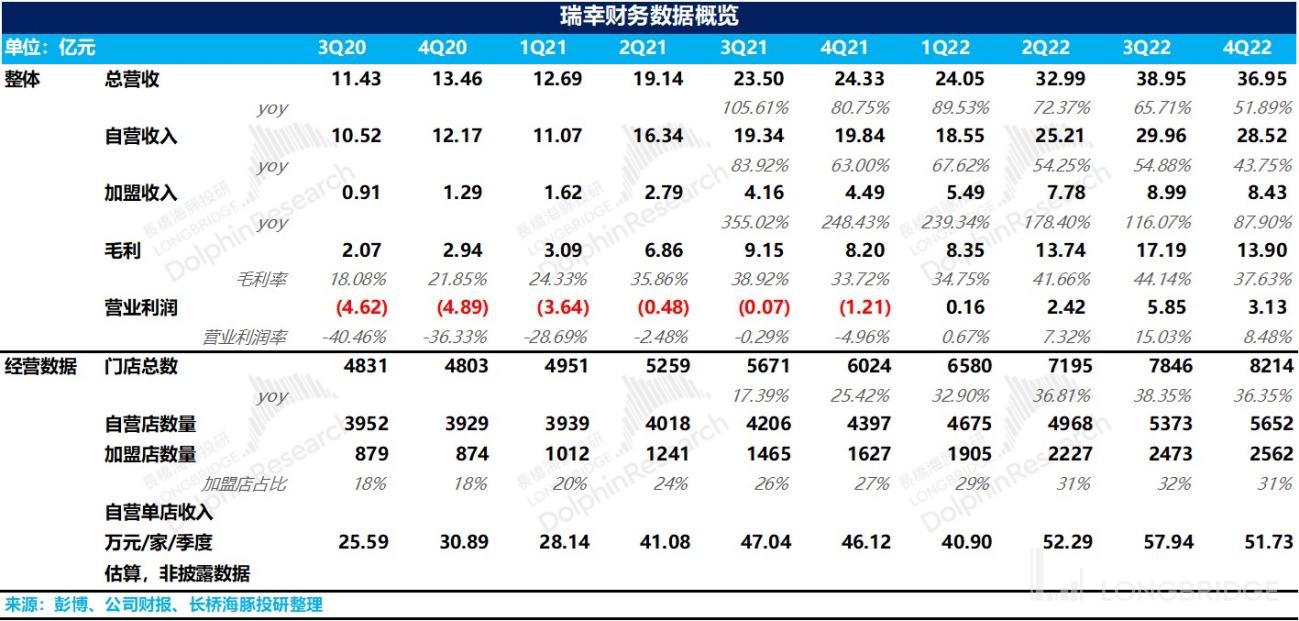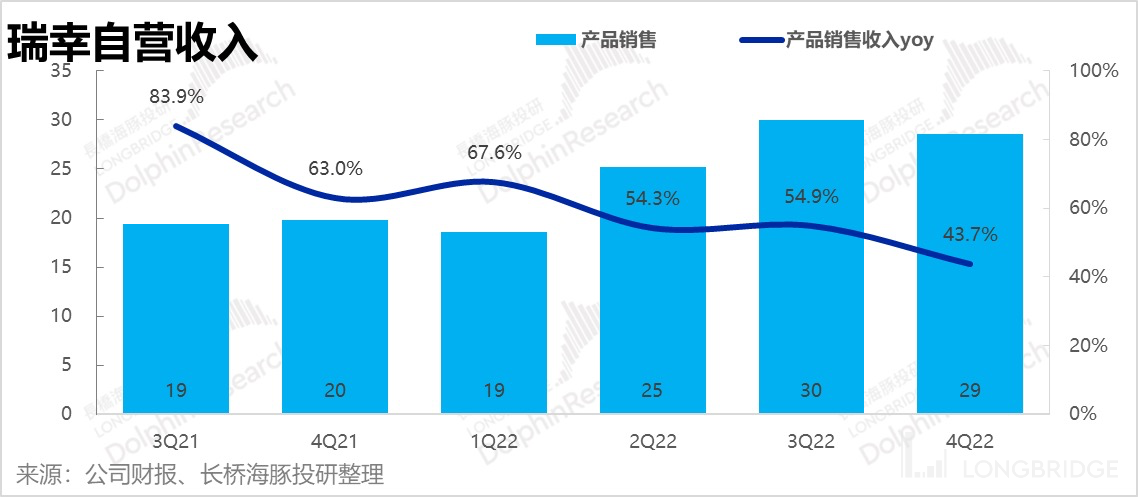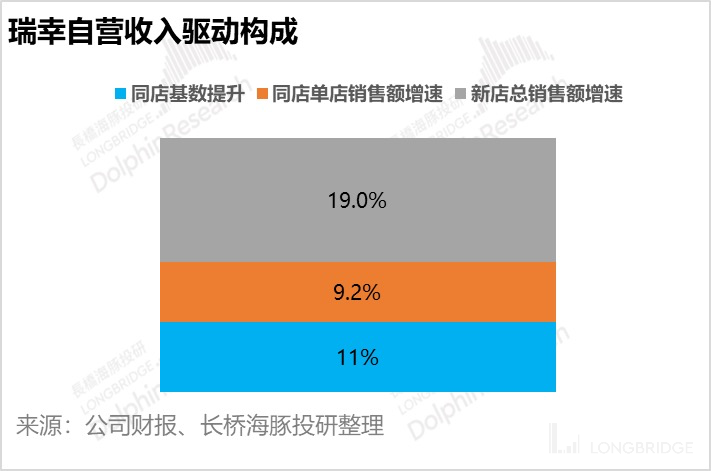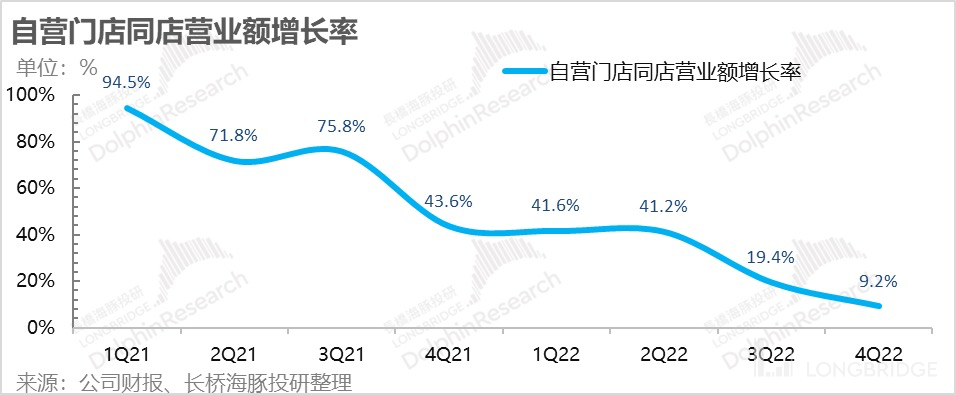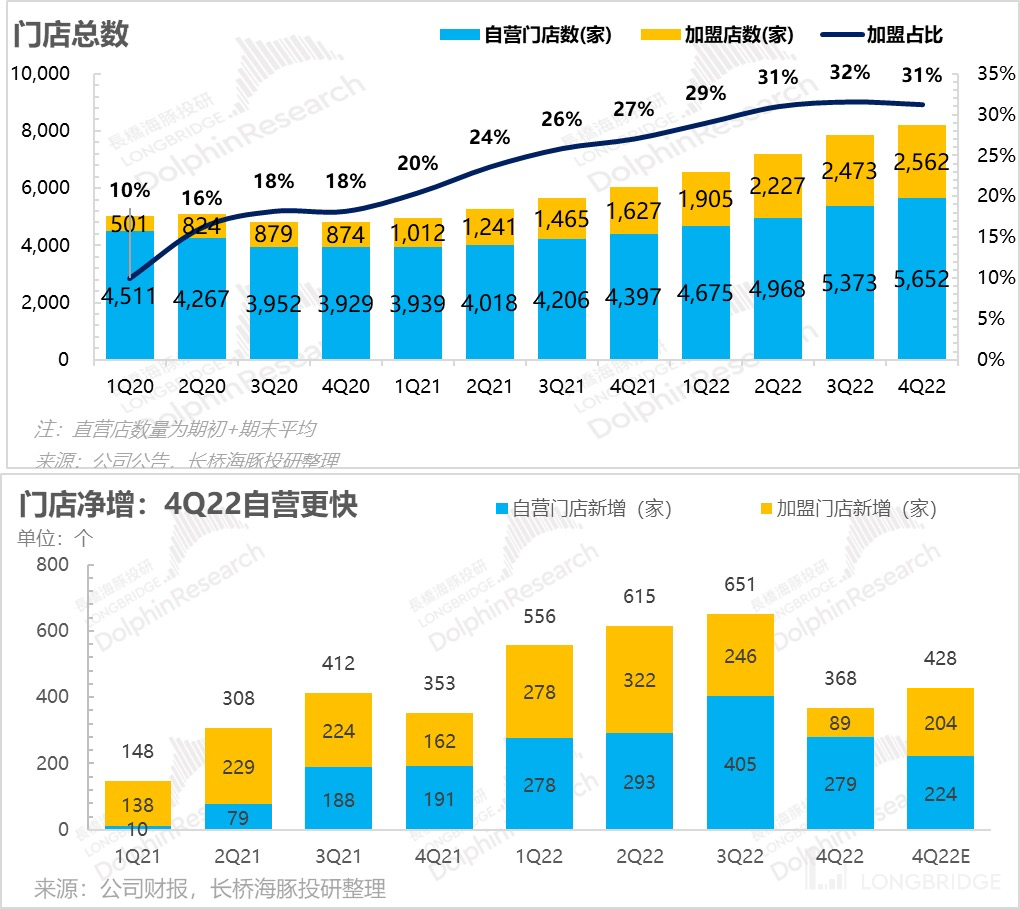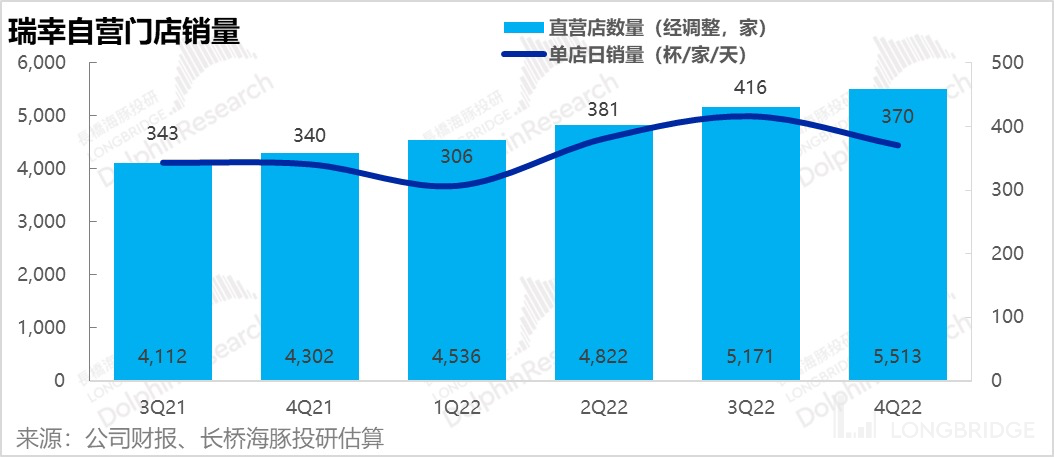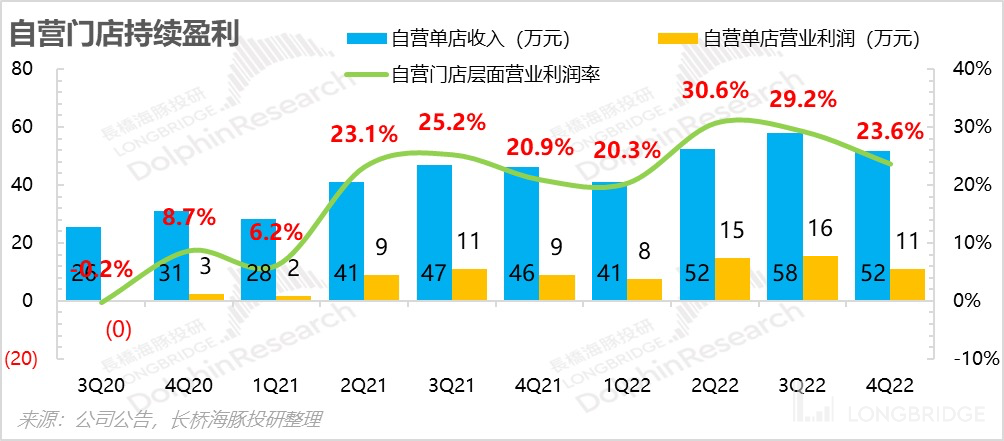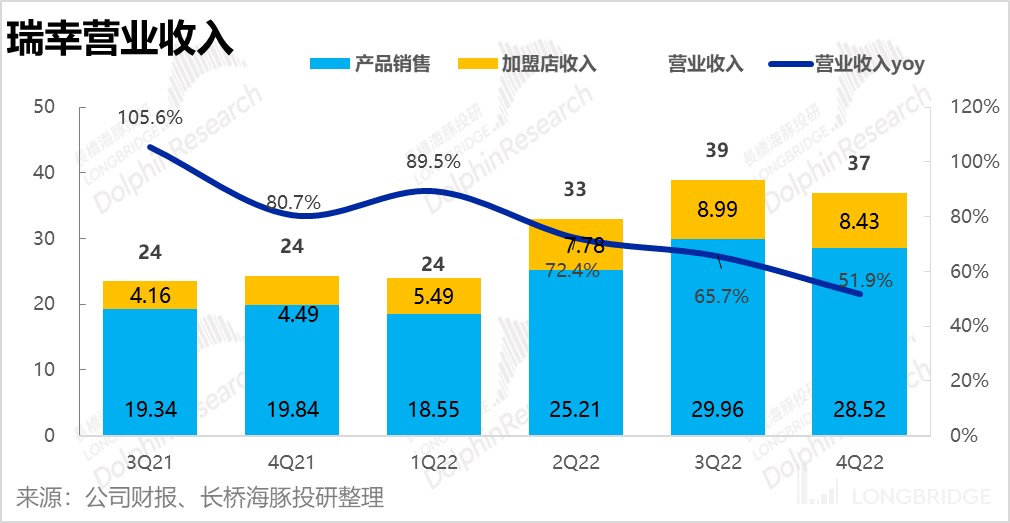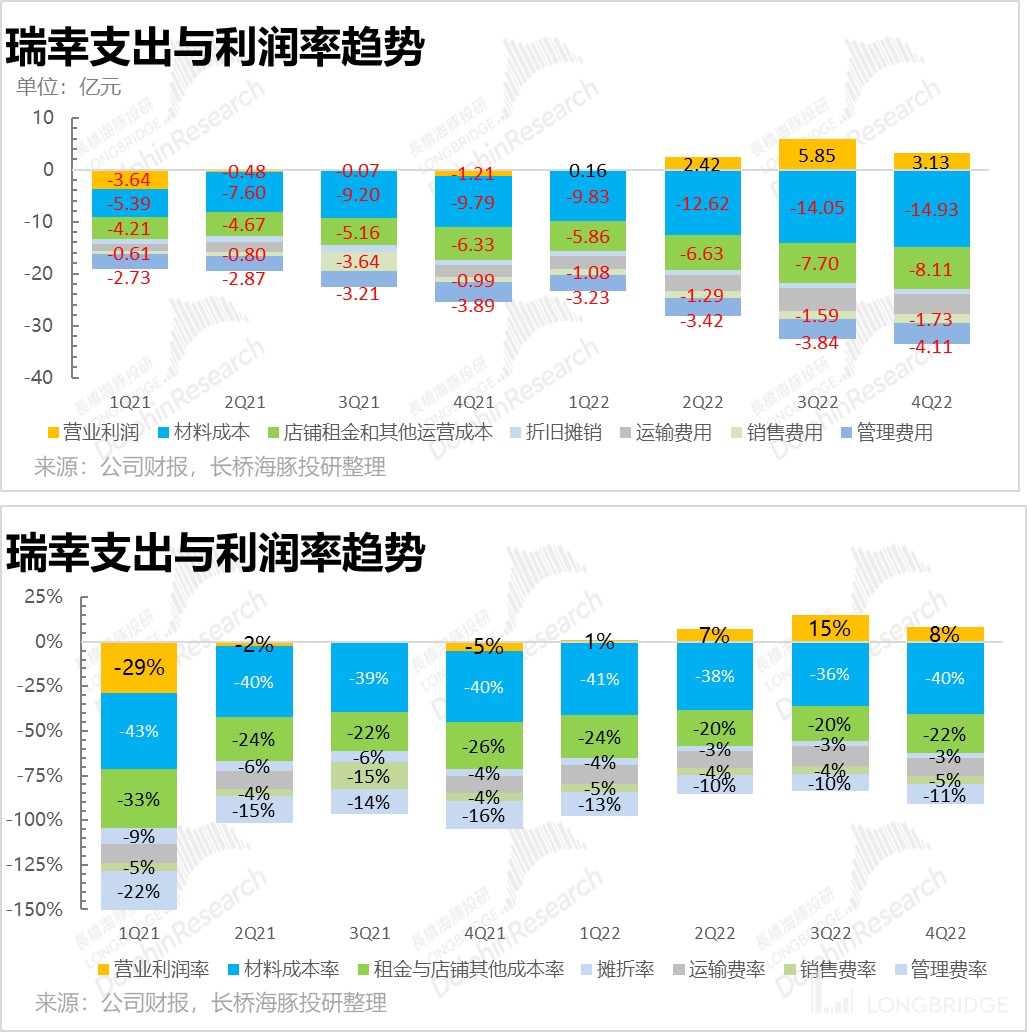
 Likes Received
Likes Received Posts
Posts新瑞幸 "Reborn from the Fire"

On the evening of March 2, Beijing time, Ruixing ($ Ruixing coffee (ADR). US) released its Q4 2022 earnings report before the opening of the US stock market. The sudden release of financial reports caught many off guard. As a newly covered consumer stock, Dolphin Analyst observed Ruixing's performance in extreme business environments to gain insight into the quality of the company.
1. Comparable to peak season, and direct and franchise stores are equally impressive: Revenue not only maintained a high growth rate of 50%+ YoY, but was also almost comparable to the peak season in Q3, which is truly remarkable.
Both direct and franchise stores performed relatively stably, with no weak points. Among them, self-operated stores still achieved a 9% YoY growth in same-store sales in the extreme business environment, showing that Ruixing's digital technology is effective and has indeed chosen stores with stronger resource endowments.
2. Continued expansion despite the epidemic: Expanding stores drives valuation stage, and opening new stores is a top priority. Despite the epidemic, stores are still expanding rapidly, with better expansion of self-operated stores compared to franchise stores due to the impact of the epidemic, which slowed down franchise store openings (a new round of Recruitment of franchisees was opened in December, with a slight decrease of only 0.3 percentage points compared to Q3).
3. Gross profit margin is acceptable: Mainly due to the impact of the transition from off-season to peak season. There was nearly a 7 percentage point MoM decline, with material cost rate rising and affecting an increase of more than four percentage points, while store rent and other factors had a less than 3 percentage point impact. Although it seems to be more pronounced, the drag on average unit price from the paralysis of first-tier cities under the epidemic and the impact of reduced sales on fixed costs should be considered. The issue is not significant.
4. Keeping cost under control: Although the increase in relative cost is relatively high, Ruixing's costs were well controlled this quarter. Apart from sales and management expenses, which were affected by the MoM decline in sales, transportation costs were still being optimized, and the overall performance was very good.
5. Operating profit: Over 300 million, with positive profits achieved even under the epidemic, and a profit margin exceeding 8%, which is better than the performance in Q2. The seemingly small net profit is mainly the problem of taxes, and need not be given too much attention.

Dolphin Analyst's overall view:
Before Q3 last year, Ruixing was in a state of rapid growth, so YoY and MoM combined would be a more scientific way to analyze. Now the company has gradually formed a larger base, so the decline in growth rate from 70% to 50% is a relatively normal state.
The peak season for coffee consumption is in summer. In Q3 last year, the revenue performance was already very good. But in contrast, due to the lifting of control measures in December, the infection rate increased sharply, and many consumers were staying home and "lost their sense of taste," leading to a significant reduction in demand for coffee. Therefore, it is not easy for Ruixing to continue to expand its stores to stabilize revenue growth.
Therefore, the decline in same-store sales MoM in Q4 compared to Q3 (still increasing YoY), and changes in gross profit margin are not indicators of poor business performance, but a natural transition from peak season to off-season as the company matures (rapid growth stages such as climbing uphill are less noticeable due to the small base, such as in Q3 and Q4 of 2021). Overall, Luckin Coffee's first half has ended, and it can be said that it has completely emerged from the shadow. What Dolphin Analyst is more concerned about is Luckin's second half, which involves joining in the sinking market.
At this moment, the clarion call of the sinking market battle has already sounded, with some brands investing heavily in technology, such as increasing investment in digital construction, and other brands using magic, such as openly imitating competitors' stores. Regardless of the method used, they are all eying the low-tier cities.
In the face of increasingly fierce competition in the freshly ground coffee market, Luckin Coffee is very confident in opening its 10,000th store this year, which means adding 2,000 new stores, maintaining a high growth rate, and achieving a new store rate of 20% by the end of the year.
How can Luckin Coffee maintain its core competitiveness? You can follow Dolphin Analyst's upcoming in-depth report on Luckin.
As a research team of Dolphin, we are committed to interpreting global core assets across markets, grasping deep value and investment opportunities for users. Interested users can add the WeChat ID "dolphinR123" to join the Dolphin research community and discuss global asset investment views together!
Below is a detailed analysis:
1. Surefire race dividend: 9% positive growth under the ultimate environment of same-store sales
Dolphin Analyst mentioned in a previous in-depth report that freshly ground coffee is currently in the race period of the dividend. Let's use Luckin's latest business data to verify this first.
Luckin's self-operated store business revenue in the fourth quarter was RMB 2.85 billion, a year-on-year increase of 44%. The double impact of the epidemic and the off-season caused its revenue to drop slightly by just over RMB 100 million month-on-month, and the year-on-year growth trend slowed down by ten percentage points, but it is still extremely promising.

Here, Dolphin Analyst made a rough breakdown of the revenue source of self-operated stores. Roughly speaking, 10% of the 44% self-operated revenue growth in Q4 is achieved through the growth in the number of old stores (according to the number of same-store sales provided by the company); 9% is achieved through the year-on-year growth in the sales of old stores; and nearly 20% is contributed by the new stores' revenue.

Obviously, the key to this growth-oriented model lies in the growth rate of same-store sales. Only if the same-store sales are growing positively, can the stores continue to expand. Fast same-store growth indicates that the market is not yet saturated.

In the extremely fast-paced expansion of stores (1-2 year-old stores account for 30% of Luckin's total number of stores), while same-store sales are still growing positively in an extreme environment, Luckin's expansion model has already been established in more than half (the other half depends on the quality of income- checking the profitability of stores). Under these circumstances, the most important task should be **expanding them. Analysis from the perspective of the Internet economy also verifies that the key to Luckin's current success still lies in continuous expansion - this can be roughly seen from the number of people buying Luckin coffee, the number of times a person places an order, and the amount of money spent in a single month:
Luckin's growth basically comes from the growth of its user base, with slight changes in monthly order frequency and purchase amount, but the changes are very small. Whether it is online or offline, the business of Luckin's basic stores is within a radius of 3-5 kilometers, and the surge in user numbers basically corresponds to the high-speed expansion of Luckin's stores.

2. Expansion: Franchisees Affected by Epidemic, Self-operated Expands Rapidly
The strategy during the expansion phase is to open franchisees. Historically, the proportion of Luckin's franchise stores has been increasing since its open franchise strategy began, which is proof of the success of its single-store model.
However, the upward trend in the fourth quarter of last year did not continue, mainly because the epidemic has impacted the franchise’s store expansion. Nevertheless, preparations for the self-operated stores are still ongoing, resulting in a considerable net increase in total stores.

At the end of 2022, the company reopened the first round of recruiting covering 41 cities in 9 provinces. In late January of this year, the recruitment scope was expanded to 80 cities in 15 provinces. Based on these efforts, the company is confident that it will exceed 10,000 stores by the end of this year.
It is worth noting that as the stores opened this year will enter a stage of maturity next year, as long as the same store turnover is still rapidly increasing, it will lay a foundation for next year's growth.
For example, by the end of 2022, the proportion of newly added stores within a year is expected to reach about 28%, which is equivalent to similar growth in the number of same-store sales next year.
Looking at the long-term prospects, Dolphin Analyst believes that the main opportunity lies in the expansion of the lower-tier markets. On the one hand, daily sales of mature stores are basically around 400-500 cups. If it exceeds this number, the usual way to address this is to open a new store; otherwise, it will allow competitors to seize the opportunity and divert business.
On the other hand, the current unit price is about 16 yuan (for package deals; the price can reach 18 yuan for individual items), which is basically at the top of the price range. It is difficult to continue raising prices and differentiate from space providers such as Starbucks. Moreover, raising prices at this time is very disadvantageous for expanding into lower-tier markets.
Similarly, Happy Tea owned by MXIC currently undergoes an expansion period and is priced under 10 yuan. Similarly, the original team of Kudy Coffee basically copied Luckin's early development routine and used even lower prices.
Between adversity and challenge, Luckin cannot find a winning space and can only continue to work hard to open new stores while the brand still has high value (represented by very full daily sales). 2. Single-store model: How is the growth quality?
And before this, perhaps everyone did not experience the difference between the third and fourth quarters so clearly. After all, Luckin's single-store revenue has always maintained a trend of quarterly increase.
From Dolphin Analyst's estimated data, although Luckin's new stores continue to increase as a proportion, the average sales volume of the overall stores has not been dragged down after new stores continue to join, and it can barely reflect the seasonality. It has been in a state of steady growth.
But this fourth quarter is an exception. The changes in the epidemic in November and December caused a decline in its daily sales per store. A store sells about 370 cups a day, while it was close to 420 cups in the scorching third quarter.

Let's take a look at the single-store revenue of self-operated stores: # Due to the impact of the cup number of single-store sales, the fourth quarter single-store sales were 520,000 yuan, lower than the peak season of 580,000 yuan in the third quarter. The key is not only the impact of peak and off-season, but also the impact of this epidemic. For example, Shanghai and Beijing, as the main operating areas of Longbridge stores, have been more severely affected by the epidemic. If the impact of the epidemic is excluded, Longbridge's same-store growth can actually be maintained at a double-digit level. Starting from the first quarter, store operations have indeed been rapidly restored.
However, at present, the quarterly revenue of a single store has exceeded 500,000 yuan, with an average daily sales of nearly 400 cups. If the future single-store revenue is to further increase, it depends on the effect of the new stores climbing up.
The operating profit of a single store reached 110,000 yuan, and the profit margin fell to 24%, mainly due to short-term dragged-down profit margin of rental costs, sales, and management expenses that will not be reduced due to impact.

3. Revenue is quite stable
In the fourth quarter, Luckin's overall revenue was 3.7 billion yuan, a year-on-year increase of 52%. In addition to self-operated revenue of 2.9 billion yuan, franchisees contributed nearly 850 million yuan. Among them, although the revenue of the franchisee is still in a state of high growth on a low base, reaching 88%, the proportion of new franchise stores is relatively high, and the small number of new stores opened in the fourth quarter led to a slight decline in its proportion.

4. Costs have risen slightly, and expenses are controllable
The trend of changes in costs and expenses is the key to observing the growth quality of Luckin's revenue. However, it is no longer a difficult problem under the current diluted sales of 900 million cups throughout the year, and small fluctuations in each quarter will no longer make people feel frightened.
1) Gross profit & cost: In the fourth quarter, Luckin Coffee's gross profit was 1.4 billion yuan with a gross profit margin of 38%. However, from the perspective of two dimensions of cost, the maximum variable cost of material cost and the relatively fixed cost, such as store rent, the key to improving gross profit margin is only one--the growth of sales and the dilution of rent and labor input with digital tools.
Due to the decline in single-store sales volume in the fourth quarter, the ability to dilute relative fixed costs has also weakened, leading to an increase of two percentage points in rent and other store costs. The future upward trend of gross profit margin can only be achieved through the scale effect of sales, especially the growth of sales of the same store.
In accordance with the industry's understanding, Luckin Coffee mainly enters the sinking market in the form of franchising, and the proportion of self-operation and franchising is likely to be evenly divided in the future. As franchising is commission-based, the part included in revenue will be less than that of self-operation. Store proportion accounts for 50%, and corresponding revenue proportion is about 38%. The gross profit margin of self-operation has been relatively stable (around 70%), and even if the gross profit margin of franchising increases in the future, it may have a limited impact on the overall gross profit margin (within 6-8pcts).
As for expenses, the elasticity of Luckin's cost side comes from store rent and other operating costs, while the elasticity of its expense side mainly comes from amortization and depreciation, sales, and management expenses.
Currently, the optimization space of amortization and depreciation is very limited, and after going through the crazy marketing period of buying and giving away, sales expenses can be continuously optimized mainly through management expenses (around 10% in terms of expense ratio).
In particular, management expenses are mostly logistics support and group attribute expenses. The promotion of franchised stores can help dilute management expenses and can be achieved by releasing sales.
In the extreme environment of the fourth quarter, it is clear that when the single-store sales volume decreases, the corresponding expense ratio increases, mainly due to the increase in store and sales expense ratio other than store expenses such as rent.
Finally, in the key operating profit, Luckin achieved 300 million yuan in the fourth quarter, which is still positive under extreme conditions, with a profit margin of 8%, down 7 percentage points from the third quarter.
On the surface, the net profit in the fourth quarter seems small, with only 55 million yuan and a net profit margin of only 1.5%, but this is mainly affected by taxes. The change of tax in a single quarter should not be paid too much attention to. The key is still to look at the operating profit--withstanding the dual test of the epidemic and the off-season.
Overall, Luckin Coffee, which has undergone a major overhaul, has already turned a new leaf, and the next step is to welcome the running of Luckin after reshaping its bones.
Further reading
February 14, 2023 In-depth Report "Luckin (Part 1): Taking Coffee to the Countryside, Can the Explosion in County Towns Continue?"
Risk Disclosure and Statement for this Article: Dolphin Research Disclaimer and General Disclosure
The copyright of this article belongs to the original author/organization.
The views expressed herein are solely those of the author and do not reflect the stance of the platform. The content is intended for investment reference purposes only and shall not be considered as investment advice. Please contact us if you have any questions or suggestions regarding the content services provided by the platform.

